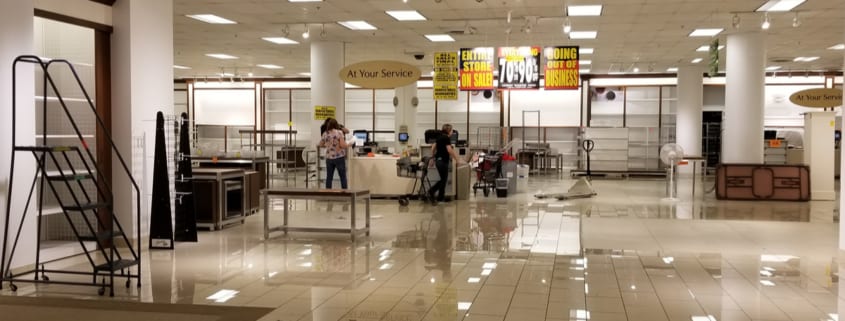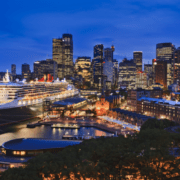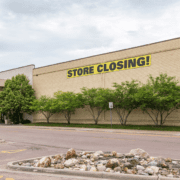Vacant Malls Create Convenient Mixed-Use Buildings for Adaptive Reuse
With United States retailers including Sears, Macy’s, and J.C. Penney announcing the closing of more than 6,000 stores in 2019 alone, shopping malls have taken a drastic hit. According to real estate research firm Reis Inc., the regional mall vacancy rate increased to 9.3% within the first quarter of the year while the growth in average rents remained the same. Shopping malls are at the heart of the “retail apocalypse”, leading experts to the prediction that by 2023 more than half of all malls nationwide will close.
As these retailers shutter more and more locations, many of the less popular malls, mainly class-B and class-C properties, are left vacant. Failure to find new tenants will cause shopping mall owners, operators, and investors to lose out on significant amounts of revenue. In an effort to minimize the amount of money they are losing, many malls have become a focal point for adaptive reuse, resulting in the redevelopment and expansion of these properties.
Keep reading to learn why vacant shopping malls have created attractive opportunities for CRE professionals and businesses interested in adaptive reuse.
Convenient Locations
Location is usually one of the main determinants when property because it can have a large impact on factors such as brand visibility, revenue, and overhead expenses. Vacant mall locations have become a coveted space for adaptive reuse because they are typically located near highways, public transportation facilities, and popular entertainment areas including restaurants, shops, and bars.
The desirable location of shopping malls has helped these facilities to transition into a variety of new spaces including offices, apartment buildings, college campuses, and schools. For example, Providence Arcade in Rhode Island, America’s oldest shopping mall, which is located in the downtown district of the city, is now home to affordable micro-apartments. The former mall’s convenient location to the heart of the business district and its walkability was able to drive the success of the newly adapted apartments by eliminating tenants’ worries about commuting and paying for parking.
Large Open Spaces
Indoor and outdoor shopping malls have become increasingly popular for adaptive reuse because of the large open spaces and abundance of parking that they offer. These spaces are convenient for housing large office buildings or hospitals, which both experience a high number of occupants on a daily basis.
Earlier this year, Google announced that it had agreed to lease the entire Westside Pavilion shopping center in Los Angeles with plans to convert it into an additional office campus. This redevelopment of the 584,000-square-feet mall is an example of how attractive the large open-space floorplans associated with shopping malls have become to companies that are interested in adaptive reuse facilities.
Multiple Uses
Old suburban shopping malls are frequently repurposed into mixed-use developments including multi-family living, hotels, gyms or yoga studies, co-working office spaces, retail and entertainment venues, and sometimes even civic amenities such as libraries or post offices. According to JLL’s survey of 90 super regional and regional malls that are undergoing or have undergone a significant renovation since 2014, 30% of them reported these renovations to be non-retail related. Apartment living, hotels, and office buildings ranked as the top mixed-use developments at 41%, 33%, and 26%, respectively.
As non-traditional tenants are added into the space, finding the right combination of occupants who will be able to increase revenue is important. To appeal to the 72% of Millennials who prefer to spend money on experiences rather than material things, mall owners and developers often gravitate towards experiential mixed-use additions that will drive foot traffic, including restaurants, movie theaters, and entertainment centers.
Tenant Success
Within the next ten years, it is predicted that about 90% of all new development will involve existing buildings. However, before making drastic developmental decisions to preexisting establishments, such as shopping malls, it is crucial for developers to understand the macro trends affecting demand for commercial space to ensure that they are “ahead of the curve” and able to successfully attract tenants.
Large, once successful malls have experienced losing many of their anchor tenants due to stores relocating or closing altogether. Regardless of the reasoning behind losing these tenants, owners and developers of malls that have undergone or are preparing to undergo adaptive reuse must consider the value of the redeveloped space and how new tenants might thrive despite the failures of previous tenants.
Some mall owners and developers are preparing for tenant success by adapting these spaces to accommodate the rapid growth of the experiential retail trend and differentiating the types of retail offerings.
Read Adaptive Reuse: What to Do with Vacant Commercial Property to learn more about adaptive reuse and additional ways that commercial properties are being repurposed.











